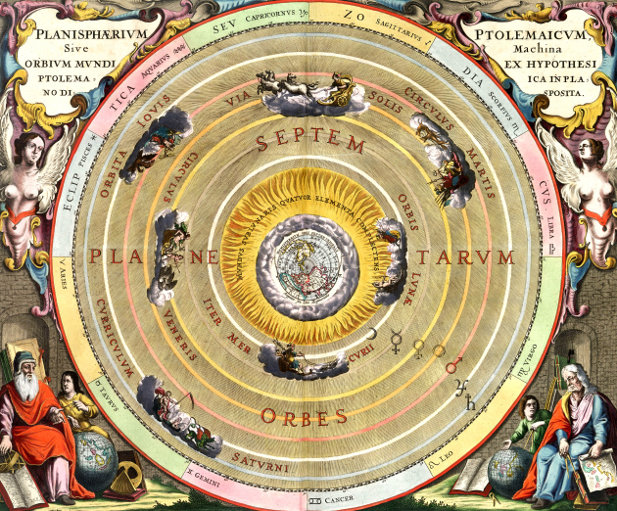The Copernican revolution. Displacing man from the center of the universe…
…But other things preoccupied him as well. In 1497 his uncle had succeeded in obtaining his election as canon of Frauenberg Cathedral, one of the chapter of ecclesiastics who, independently of the bishop, ran the secular and religious affairs of the cathedral. But Copernicus was in no hurry to settle down, and preferred to stay in the intellectually exciting world of Italy. He went to Rome for the jubilee year of 1500, partly as a tourist, partly to enjoy the riches of its great libraries. He stayed in Rome for a year, supporting himself by teaching mathematics; his lectures presumably on astronomy were later reported to have drawn “a throng of great men and experts.”

—When the Greek astronomer Ptolemy approached this issue, he believed that the Earth ought to hold a privileged place in the cosmos, so he put it at the center of his system, and had the heavenly bodies move basically on circles centered on the Earth. Unfortunately, this didn’t even come close to accounting for the actual observed motions, so Ptolemy added epicycles.
An epicycle is a second circle with its center moving along the main circle. These strange orbits turned out to describe the motion of the Sun, Moon, and planets fairly well.
Of course, “fairly well” is not well enough for astronomers. To get better accuracy, some adjustments needed to be made to Ptolemy’s system.—Read More:http://www.black-holes.org/relativity1.html
After this obviously exciting year he went back home to be installed as canon- and promptly secured leave of absence to study for another five years. This time he went to Padua,famous for law and medicine and with a distinguished tradition in astronomy as well. Here he completed his legal studies, here he obtained the knowledge that later permitted him to practice medicine, and here he acquired a fair knowledge of Greek, all in the best humanistic tradition.
In 1506, his leave of absence up, Copernicus returned to Frauenburg, only to have his uncle call him away to the episcopal palace at Heilsberg in the center of Ermland. Until the bishop’s death in 1512 Copernicus acted as his uncle’s physician and administrative assistant, helping to keep Ermland independent of the Teutonic Knights and the king of Poland and gaining valuable diplomatic experience.

—The man in the center represents Earth; the twelve energy lines radiating out from him into golden circles (some with flower petals) represent the twelve main zodiacal constellations. Sixty green leaves sprout from these energy lines, representing the sixty minor constellations of the night sky. …Chris Sedgwick…Read More:http://fineartamerica.com/featured/the-geocentric-universe-chris-sedgwick.html
Evidently his uncle also encouraged his intellectual pursuits, for in 1509 he published a Latin translation of an obscure seventh century Byzantine poet, dedicating the work to his uncle. This scholarly contribution also contains a laudatory poem by a friend, which speaks admiringly of the translator’s classical learning and, as well, of his study of the motions of the moon and the planets. (to be continued)…
ADDENDUM:
(see link at end)…The generally accepted world system, the geocentric system, was formulated by Aristotle about 350 BC, and further elaborated by Ptolemy about 150 AD. It held that the Earth was the centre of the universe, and that the Moon, Sun and planets were attached to crystal spheres revolving around the Earth. All motions were perfectly circular. Gravitation was a phenomenon applying to the Earth only, as an expression for things seeking their natural place. However, the ptolemean system could not explain certain aspects of planetary motion that were frequently observed. Instead, Copernicus suggested in his book “De Revolutionibus Orbium Coelestium”, 1543, that a system with the Sun in the centre, with the Earth as a planet among the others, would explain the observed discrepancies. Although Tycho’s data would fit the Copernican model nicely, he was in doubt because of the problem with gravitation. If the natural equilibrium for things was on the Earth, how could it be outside the centre in the world system? Tycho therefore devised his own system, with the Earth still in the centre, but no crystal spheres and some of the planets orbiting the Sun instead of the Earth. Tycho Brahe published his worlds system in 1588 in the book “De Mundi Aetherei Recentioribus Phaenomenis” (On Some New Phenomena).Read More:http://www.tychobrahe.com/uk/astronomen.html





 COMMENTS
COMMENTS